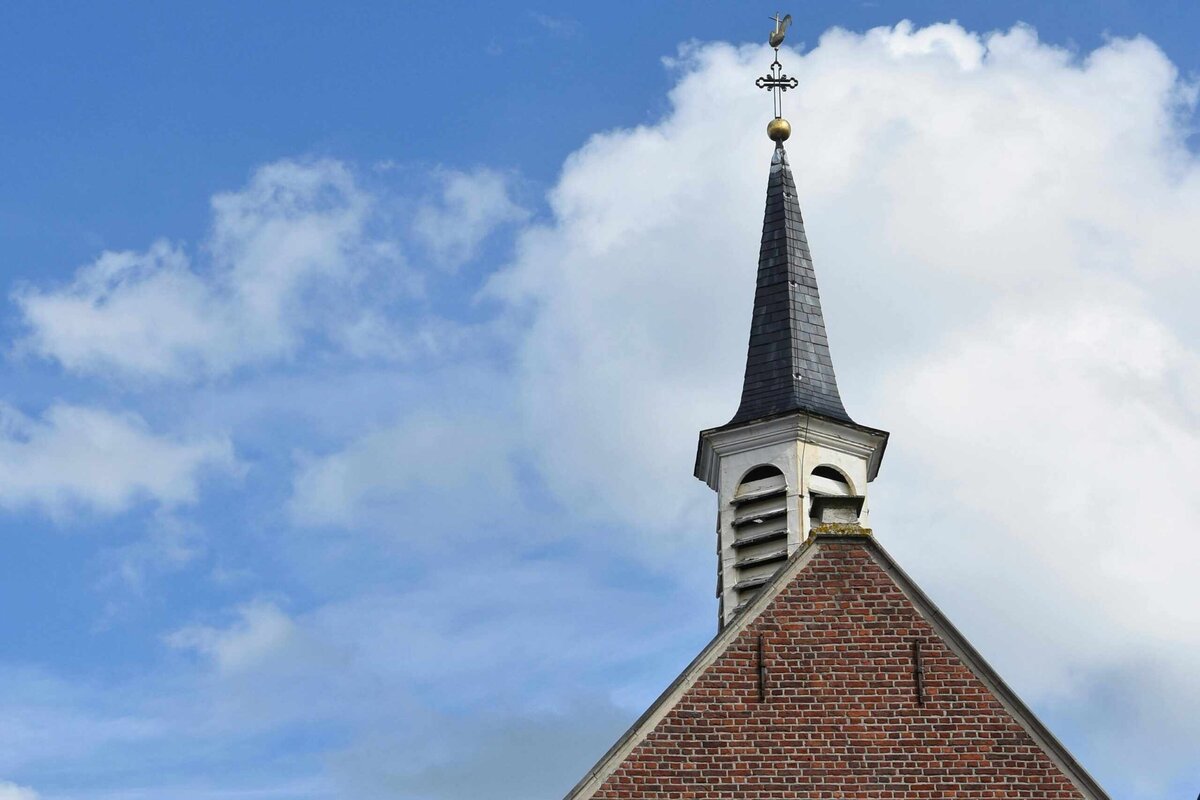Church steeples, those soaring structures that pierce the sky above many religious edifices, are not just architectural feats but are also rich with symbolic meanings and historical significance. Have you ever wondered what mysteries and messages are woven into the hidden symbolism of church steeples? This blog post delves deep into the fascinating world of these iconic symbols, exploring their origins, the spiritual symbolism they embody, and how they’ve transcended mere architectural features to become beacons of faith and community. From guiding the lost to their spiritual home to representing the connection between heaven and earth, church steeples carry a multitude of meanings that often go unnoticed. Whether you’re a history buff, architectural enthusiast, or someone intrigued by the cultural significance of religious symbols, this exploration will uncover the layers of meaning behind these towering structures. Join us as we climb the heights of understanding, shedding light on why these features remain pivotal in both historical contexts and modern-day spiritual practices.
What Are Church Steeples? Unveiling the Architectural Marvel
Unveiling the Architectural Marvel of Church Steeples
Church steeples, those lofty spires that dominate the skylines of many towns and cities across the world, are not just architectural feats but also emblems laden with historical and spiritual significance. These towering structures are often perceived as a bridge between the earth and the heavens, urging the viewer’s gaze upward while symbolizing the aspiration towards higher values.
Historical Roots and Architectural Evolution
The origin of church steeples can be traced back to the early church structures in Europe during the Middle Ages when it became customary to build churches in the shape of a cross. Architects and builders began to incorporate a tall, tower-like structure at the church’s entrance, which evolved into the steeple. Originally, these were simple, square towers. As architectural techniques advanced, they transformed into the elaborate spires seen today, often adorned with intricate carvings, clocks, and bells which served to call the faithful to worship and mark the passage of time.
The architectural styles of steeples have varied greatly depending on the period and location. From the simple, stark steeples of early Romanesque architecture to the ornate, flamboyant spires of the Gothic period, each style reflects its own theological and aesthetic considerations. In modern times, the designs of church steeples continue to evolve, incorporating contemporary materials like steel and glass, yet they still retain their symbolic essence.
Symbolism Behind Church Steeples
The symbolism of church steeples extends far beyond their architectural appeal. Spiritually, steeples have always held a significant role in symbolizing the church’s reaching out to the divine. They are often the highest point in the area, pointing towards heaven as a physical representation of the prayers of the congregation ascending to God.
Moreover, steeples are often topped with a cross or a weather vane that often features a rooster, which has biblical symbolism related to vigilance and the call to repentance. This placement at the highest point symbolizes the supremacy of Christ and the role of the church as a guide to the community.
Structural and Practical Insights
From a practical standpoint, church steeples serve several functions. Historically, they housed bells, which were used not only for calling the faithful to service but also for signaling important community events and alarms. In many rural communities, the steeple functioned as a landmark for travelers and as a symbol of communal pride.
The construction of a steeple is a feat of both engineering and art. The framework typically involves a durable, yet lightweight, material capable of withstanding the elements while supporting the weight of the bells and other structural elements. The interior of a steeple might also be used for practical purposes, housing everything from bell mechanisms to clockworks, and in modern settings, even communication equipment.
Conclusion
Church steeples, therefore, are much more than just architectural statements. They are a confluence of history, art, spirituality, and
The Origins of Church Steeples: A Journey Through History
The Origins of Church Steeples: A Journey Through History
The church steeple, a common sight in skylines around the world, holds a storied history and a wealth of symbolism. These towering structures are not just architectural feats; they are deeply rooted in the cultural, spiritual, and historical tapestry of Christianity.
Historical Beginnings
The origin of church steeples can be traced back to the early centuries of church architecture, evolving from the Romanesque period through the Gothic era. Originally, church steeples served a practical purpose—they housed the bells that called the faithful to worship and marked the time of day. However, as architectural styles advanced, so too did the aesthetics and symbolism associated with steeples.
In medieval Europe, the construction of church steeples became increasingly elaborate. Gothic architecture, known for its height and heavenly aspirations, saw steeples becoming taller and more intricately designed. The height of these steeples was not merely for function but was imbued with symbolic meaning, pointing towards the heavens and directing the eyes and spirits of onlookers upwards, reminding them of the spiritual realm.
Architectural Evolution and Cultural Significance
As architectural techniques evolved, so did the design and complexity of church steeples. By the Renaissance and Baroque periods, steeples were not only markers of religious devotion but also displays of architectural prowess and community pride. In many small towns, the church steeple was often the tallest structure, symbolizing the church’s central role in daily life and its spiritual authority.
In addition to their religious and communal roles, steeples also played a part in navigation, serving as landmarks for travelers and sailors. This dual functionality underscores the steeple’s importance in both spiritual guidance and practical orientation.
Exploring the Hidden Symbolism Behind Church Steeples: A Deep Dive
While the architectural and historical aspects of church steeples are well-documented, the underlying symbolism is equally rich and varied.
Spiritual Ascent and Divine Connection
The most prominent symbolism of the church steeple is its representation of the connection between earth and heaven. By reaching towards the sky, steeples visually express the idea of ascending to God and the heavenly domain. This vertical emphasis can be seen as a metaphor for spiritual ascent, striving from the earthly to the divine, which is a common theme in many religious practices.
Light and Guidance
Many church steeples are topped with a cross or weather vane, often gilded or made reflective to catch the light. This not only serves a decorative purpose but also symbolizes the role of the church as a beacon of hope and guidance. The reflective surfaces that catch the light symbolize enlightenment, both spiritual and intellectual, guiding the community’s moral compass.
Community Identity and Continuity
Steeples, often funded and constructed through communal efforts, also symbolize the unity and strength of a community. They stand as enduring symbols of the local community’s identity, history, and continuity, marking
Symbolic Meanings of Church Steeples: More Than Just Height
Exploring the Hidden Symbolism Behind Church Steeples: A Deep Dive
Church steeples are a prominent feature of religious architecture, soaring skyward from the rooftops of churches around the world. But beyond their architectural beauty, these structures are imbued with deep symbolic meanings, reflecting spiritual ideals, historical significance, and community values. This article will explore the multifaceted symbolism of church steeples, offering a comprehensive look at their origins, meanings, and the roles they play in the cultural and spiritual life of communities.
Historical and Cultural Origins of Church Steeples
The origin of church steeples can be traced back to several architectural traditions. Historically, they are thought to have evolved from the obelisks of ancient Egypt and the towers of Romanesque architecture. The Gothic period saw church steeples becoming increasingly lofty and elaborate, symbolizing a reaching toward heaven and the divine. This architectural feature was not only a symbol of religious aspiration but also served practical purposes, such as housing bells and providing a landmark for travelers.
Symbolic Meanings of Church Steeples
Ascent to the Divine: One of the most prominent symbolic interpretations of church steeples is their representation of the connection between earth and heaven. The vertical lines of a steeple guide the eye and spirit upwards, encouraging contemplation of the higher power and the spiritual realm.
Guidance and Refuge: Steeples often housed bells, which were used to call the faithful to worship and to mark the hours of the day. The sound of the bells served as a guide to community members, reminding them of the presence of God and offering comfort during times of distress.
Light and Illumination: Many steeples are topped with a weather vane or cross, often gilded or made reflective to catch the light. This feature symbolizes the role of the church as a beacon of hope and ethical illumination in the community, guiding the moral compass of its followers.
Architectural Witness: Steeples, often the highest point in a landscape, serve as silent witnesses to the lives of the people within their communities. Over centuries, they have watched over the joys, sorrows, and everyday lives of generations, standing as a testament to the enduring nature of faith.
Architectural and Community Significance
In many communities, the church steeple is more than just a religious symbol; it is a focal point of the town or cityscape. Its prominence in both height and style often reflects the community’s values and historical priorities. In some cases, the height of church steeples was influenced by local ordinances or by competitions between congregations to build the tallest landmark, reflecting a community’s pride and competitive spirit.
Contemporary Interpretations and Uses
In modern architecture, the design of church steeples continues to evolve, incorporating new materials and technologies. However, even contemporary steeples remain deeply symbolic, reflecting both a respect for tradition and a move
How Do Church Steeples Influence Community Spirituality?
Exploring the Hidden Symbolism Behind Church Steeples: A Deep Dive
Church steeples, those towering, pointed structures that rise gracefully from the roofs of churches, are more than just architectural features. They hold deep symbolic significance and play a vital role in community spirituality. This article delves into the history, symbolism, and impact of church steeples on community spirituality, providing a comprehensive analysis of their multifaceted role in religious and communal life.
The Historical and Architectural Significance of Church Steeples
The church steeple, with its origins tracing back to the Gothic architecture of medieval Europe, was primarily designed to visually draw the eyes upward, towards the heavens. This architectural choice was not merely aesthetic but deeply symbolic, suggesting a connection between the earthly and the divine. Historically, steeples served as landmarks that marked the spiritual center of a town or community. In an era before high-rise buildings, the steeple was often the tallest structure in an area, visible from miles around and serving as a guiding beacon to travelers.
Symbolism and Spiritual Implications
From a symbolic perspective, church steeples are laden with meanings. They are often seen as a representation of the connection between man and God, a physical manifestation of the spiritual journey from the mundane to the sublime. The height of steeples, pointing towards the sky, is commonly interpreted as an indicator of the church’s reaching out to God. This vertical emphasis in architecture can be seen as an invitation to reflection and a reminder of the spiritual aspirations of the community.
The use of materials and specific architectural designs in steeples also carry symbolic meanings. For instance, the use of light materials and open designs in some steeples can signify transparency and openness to divine influence. Moreover, the cross that typically adorns the top of a steeple reinforces its religious significance, serving as a potent symbol of Christian faith.
Impact on Community Spirituality
Church steeples also play a crucial role in enhancing community spirituality. As prominent features in the landscape, they are constant reminders of the presence of a spiritual dimension in everyday life. They not only guide the faithful to the place of worship but also serve as a focal point around which community activities and celebrations are centered. The steeple helps in creating a sense of belonging and identity among the community members, fostering a shared spirituality that is vital for communal harmony and cooperation.
Furthermore, the ringing of bells, often housed within steeples, marks significant communal times of prayer, celebration, and mourning. These sounds serve as auditory reminders of the spiritual and communal rhythms of life, reinforcing the church’s role in community cohesion and spiritual guidance.
Practical Insights and Conclusion
The design and maintenance of church steeples, therefore, hold significant importance not only for the preservation of historical architecture but also for the enhancement of community spirituality. Churches considering the renovation or construction of a steeple might focus on aspects such as visibility, acoustics (for bell towers), and symbolic
The Evolution of Church Steeple Designs Over the Centuries
The Evolution of Church Steeple Designs Over the Centuries
Church steeples, the soaring structures that crown the world’s places of worship, are not merely architectural afterthoughts but are imbued with profound symbolism and history. These towering features have evolved significantly over centuries, adapting to cultural shifts, technological advancements, and theological changes. This article explores the evolution of church steeple designs, delves into the hidden symbolism behind these architectural elements, and considers the modern significance of steeples in church architecture.
Historical Beginnings and Evolution
The origin of church steeples can be traced back to the early centuries of church architecture, where they began as simple wooden structures atop church roofs. These were primarily functional, intended to be seen from a distance, guiding the faithful to the place of worship. However, as gothic architecture took hold in the Middle Ages, steeples became increasingly elaborate.
In Europe, particularly in places like Germany and France, the designs evolved from square bases to intricate octagonal shapes, often adorned with spires that reached towards the heavens. This was both a reflection of the builders’ engineering prowess and a symbolic gesture, pointing up to God and visually representing the connection between the earth and the divine.
Architectural Styles and Changes
As architectural styles changed from Romanesque to Gothic, and later to Renaissance and Baroque, so too did steeple designs. The Gothic period, known for its emphasis on height and light, saw steeples becoming taller and more ornate. The introduction of the flying buttress allowed for higher and more ambitious structures, which were not only a statement of faith but also a demonstration of the era’s architectural innovations.
Renaissance and Baroque periods adapted the steeple designs to be more harmonious with their respective architectural ideals, focusing more on proportion, balance, and detailed ornamentation. The famous St. Martin’s Church in Landshut, Germany, boasts one of the tallest brick steeples globally, exemplifying the era’s engineering ambitions and aesthetic principles.
Symbolism in Steeple Design
Church steeples are rich in symbolism. Beyond their practical use in calling the faithful to prayer and housing bells, steeples represent the aspiration of humans to reach towards the heavens. They are a physical manifestation of the spiritual journey, pointing upward, guiding the viewer’s eyes and spirit towards contemplation of the higher power.
In many traditions, the steeple also symbolizes the light of God shining over the community, with the cross at the top standing as a potent symbol of Christian faith. Additionally, the height of steeples often made them the tallest structures in older towns and cities, symbolizing the church’s central role in community life and its spiritual supremacy.
Modern Interpretations and Uses
In modern times, while the religious and community significance of steeples remains, there has been a shift towards integrating traditional designs with contemporary architectural styles. Today, church steeples still serve as landmarks and are integral in defining
Decoding the Height: Why Are Church Steeples So Tall?
Decoding the Height: Why Are Church Steeples So Tall?
Church steeples, the towering structures often seen piercing the skyline above churches, are not just architectural feats but also carry deep symbolic and practical significance. In exploring why church steeples are so tall, we delve into a blend of historical, cultural, and architectural insights that reveal the multifaceted reasons behind their design.
Historical and Religious Significance
The origins of the church steeple can be traced back to the Gothic architecture era, which emphasized verticality and light. The height of the church steeple served not only as a visual call to worship but also symbolized the heavens. Rising above the earth, steeples point upwards, directing the eyes and spirit of the beholder towards the divine. This vertical emphasis reflects a common religious theme across various cultures: a reach towards the heavens or a higher power.
Architectural and Practical Considerations
From an architectural perspective, church steeples serve several practical functions. Historically, they were used to house bells, which rang for service times, celebrations, or alarms. The height of the steeple allowed the sound of the bells to travel farther, serving both practical communication purposes and ceremonial uses.
Moreover, the tall structure of the steeple makes it a natural lightning rod. This was particularly significant in earlier centuries when taller buildings were scarce, and the steeple was often the highest point in an area. By drawing lightning away from the more vulnerable parts of the church structure, the steeple served a protective function.
Symbolism and Community Identity
Steeples also play a crucial role in the identity of a community. They are often landmarks within a town or cityscape, providing a point of orientation and a sense of local pride. Their visibility makes them a central meeting point and a symbol of communal gathering.
The design of a steeple can also reflect the architectural trends of the time, as well as the cultural and spiritual aspirations of the community it serves. For instance, the simplicity or ornateness of a steeple can speak volumes about the community’s values and resources at the time of construction.
Exploring the Hidden Symbolism Behind Church Steeples: A Deep Dive
Moving beyond practicality, the symbolism embedded within church steeples reveals layers of meaning that intertwine religious, cultural, and esoteric elements. Symbolically, the steeple represents the connection between the earthly and heavenly realms. It is not only a physical reaching toward the sky but also an embodiment of the spiritual journey from the human to the divine.
The shape of the steeple itself holds symbolic meaning. Often designed in a pointed form, it mimics the ascension towards the divine and is reminiscent of ancient structures like obelisks, which were also symbolic of connection with the divine.
Conclusion
In conclusion, church steeples are tall not only for their practical utility in housing bells and repelling lightning but also for deeper symbolic
Top 5 Most Iconic Church Steeples Around the World
Top 5 Most Iconic Church Steeples Around the World
Church steeples, soaring into the skies, have been landmarks of faith, architecture, and history for centuries. These towering structures not only enhance the aesthetic appeal of churches but also carry deep spiritual and communal significance. In this article, we explore the top 5 most iconic church steeples around the world, delving into their architectural grandeur and the stories they tell.
St. Martin’s Church, Landshut, Germany
St. Martin’s Church boasts the tallest brick steeple in the world, standing at 130.6 meters. Completed in 1500, this magnificent structure is a masterpiece of Gothic architecture. The steeple’s impressive height and intricate design are not just a display of medieval engineering but also a symbol of Landshut’s historical and cultural significance.
St. Vitus Cathedral, Prague, Czech Republic
Nestled within the Prague Castle complex, St. Vitus Cathedral is a prominent example of Gothic architecture. Its steeple, rich with medieval craftsmanship, towers at 96.5 meters, offering a panoramic view of the city. The cathedral is also a vital repository of Bohemian kings’ tombs, making its steeple a beacon of Czech history and heritage.
Old North Church, Boston, USA
Famous for its role in the American Revolution, the steeple of the Old North Church is an enduring symbol of American independence. It was from this 53-meter-tall steeple that the famous signal lanterns of Paul Revere were displayed, guiding the path to freedom. Today, it stands as a pivotal site in U.S. history, attracting visitors worldwide.
Salisbury Cathedral, Salisbury, UK
Home to the UK’s tallest church spire at 123 meters, Salisbury Cathedral is an architectural jewel in the English countryside. Built in the 13th century, its steeple is an iconic feature of the Early English Gothic architectural style. The cathedral also houses the best-preserved of the four original copies of the Magna Carta, linking it to global legal history.
Basilica of Saint Epvre, Nancy, France
Though less globally renowned, the Basilica of Saint Epvre in Nancy features one of the most beautiful steeples in France. Standing at 87 meters, this neo-Gothic marvel is not only a place of worship but also a monument celebrating Lorraine’s cultural identity and historical resilience.
Exploring the Hidden Symbolism Behind Church Steeples: A Deep Dive
Church steeples transcend architectural beauty, embedding deep symbolic meanings. Historically, steeples helped make churches visible from afar, acting as guideposts for those seeking the spiritual solace of the sanctuary. Symbolically, they point heavenwards, guiding the faithful’s thoughts upwards towards the divine.
Intricately designed, steep
The Role of Church Steeples in Gothic Architecture
The Role and Symbolism of Church Steeples in Gothic Architecture
Church steeples, those lofty spires that pierce the skyline above religious sanctuaries, are not only architectural feats but also bearers of deep symbolism. Predominantly featured in Gothic architecture, these structures have transcended their initial practical purposes, evolving into powerful icons of spiritual aspiration and community identity. This article delves into the multifaceted roles and the hidden symbolism of church steeples, providing a detailed analysis that illuminates their significance in historical and cultural contexts.
Historical Emergence and Architectural Significance
The genesis of church steeples can be traced back to the Gothic period, a time characterized by a fascination with height and light. Originating in the 12th century, Gothic architecture sought to reach the heavens with its pointed arches, ribbed vaults, and flying buttresses. The steeple, evolving from the earlier Romanesque towers, became an integral part of this architectural endeavor. It was designed not only for its aesthetic appeal but also to draw the eyes and spirits of onlookers upwards, inspiring a sense of divine presence.
In terms of construction, steeples are engineering marvels. They are typically built from stone or brick, with newer versions incorporating steel or wood. The structural design allows them to withstand the elements, particularly the wind, which they encounter at such impressive heights. Their lofty position also historically served practical purposes, such as housing bells, which were used to call the faithful to worship and to mark time for the surrounding community.
Symbolism Embedded in Steeples
Beyond their architectural and practical uses, church steeples are imbued with rich symbolism. Steeples often point skywards, symbolizing the connection between the earthly and divine, reaching towards heaven as if to bridge the gap between man and God. This vertical emphasis is no mere aesthetic choice; it reflects deep theological concepts of ascension and aspiration.
Moreover, steeples often feature a cross at their highest point, a potent symbol of Christian faith that signifies sacrifice and salvation. This placement is not only a declaration of the church’s religious affiliation but also serves as a visible reminder of Christian doctrines to the community.
Steeples in Gothic Architecture: A Closer Look
In Gothic architecture, steeples are often more than just single towers. Many Gothic churches feature multiple steeples, which contribute to a dramatic and heavenly cityscape, creating a rhythm of rises and falls that echo the spiritual journey of its adherents. Notable examples include the Cologne Cathedral in Germany and Notre-Dame in Paris, where the steeples are not only functional but are key to the narrative the structure tells through its architecture.
Furthermore, the intricacy of Gothic steeple design often includes ornamental elements such as crockets and finials, each adding layers of meaning and beauty. These elements are crafted with the intention to reflect the glory of God, with every detail contributing to a larger theological discourse,
Exploring the Materials Used in Building Church Steeples
Exploring the Materials Used in Building Church Steeples
Church steeples, those lofty spires that grace the rooftops of churches around the world, are not just architectural feats but also rich with symbolism. The choice of materials used in constructing these iconic structures is as varied as their designs and holds significant importance.
Wood and Timber: Historically, wood has been the primary material used for steeple construction, especially in Europe and North America. Timber is not only structurally sound, providing the necessary height without excessive weight, but it also offers a natural aesthetic that complements many church designs. Moreover, wood is relatively easier to carve and shape into the intricate designs often seen on church steeples.
Stone and Masonry: In regions where stone is abundant, church steeples are often constructed from this enduring material. Stone steeples are hallmarks of durability and strength. They can withstand harsh weather conditions, making them particularly popular in areas prone to severe weather. The weight of stone steeples, however, requires a robust foundation, which can significantly increase construction costs.
Metal: Advancements in metallurgy have introduced metals like steel and aluminum in steeple construction. These materials are favored for their longevity and resistance to fire and pests. Metal steeples can be pre-fabricated, which allows for more precise and complex designs. They are also lighter than stone, which reduces structural stress on the church building.
Fiberglass and Other Modern Materials: In contemporary steeple construction, materials like fiberglass are increasingly common due to their versatility and low maintenance. Fiberglass can be molded into virtually any shape and finished to look like more traditional materials such as wood or stone. It is also resistant to corrosion, making it ideal for churches in coastal or high-humidity areas.
Exploring the Hidden Symbolism Behind Church Steeples: A Deep Dive
The steeple is one of the most recognizable features of church architecture, rising above the skyline and pointing heavenward. This design is not merely aesthetic but deeply symbolic.
Reaching Towards Heaven: The most apparent symbolism of a church steeple is its reach towards the sky, symbolizing the church’s role in connecting the earthly realm with the divine. It serves as a visual reminder of the heavens and encourages contemplation of the spiritual life.
The Light of God: Many church steeples are topped with a cross and often include features such as weathervanes or lanterns. These elements are not only decorative but signify the belief that the church is a guide and shelter from the storms of life, pointing the way and illuminating the darkness.
Community Gathering Point: Historically, the steeple served as a landmark for towns and cities, guiding people not just spiritually but also physically. It marked a place of sanctuary and gathering, fostering a sense of community and belonging among the local populace.
Architectural Acoust
How Modern Architects Redefine Church Steeples: A New Era
The Evolution and Symbolism of Church Steeples: From Traditional to Modern Designs
Church steeples have stood as prominent features of religious architecture for centuries, piercing the skyline with their often imposing and intricate designs. Traditionally, these structures not only enhanced the aesthetic appeal of churches but also served as symbolic beacons of faith, guiding the community to a spiritual haven. However, as architectural styles and societal norms evolve, modern architects are redefining church steeples, integrating contemporary design elements that reflect a new era while exploring the deep-seated symbolism that these architectural features carry.
Redefining Church Steeples in Modern Architecture
The role of the church steeple in modern architecture has seen a transformative shift with architects incorporating innovative designs that blend functionality with aesthetic appeal. Unlike the traditional steeples which primarily featured Gothic or Romanesque styles, modern steeples often utilize cutting-edge materials like glass, steel, and composites. These materials not only offer durability and ease of maintenance but also allow for more creative freedom in design.
One of the pioneers in this architectural revolution is the use of eco-friendly materials and technologies. For example, some contemporary church steeples are designed to house solar panels, supporting the church’s energy needs while promoting environmental stewardship. This functional redefinition not only modernizes the steeple’s role but also aligns it with broader global initiatives towards sustainability.
Furthermore, the architectural form of modern steeples often reflects the community’s identity and cultural context. Architects are increasingly focusing on creating designs that resonate with the local environment and community values, making each steeple unique and personally relevant to its congregation. This personalized approach fosters a deeper connection between the architecture and its community, enhancing the church’s role as a local landmark.
Exploring the Hidden Symbolism Behind Church Steeples
The symbolism of church steeples runs deeper than their historical role as watchtowers and bell towers. Traditionally, steeples have pointed towards the heavens, directing the gaze and thoughts of onlookers upwards, symbolizing the connection between the earthly and the divine. This vertical emphasis is not only a reminder of the spiritual aspirations of humanity but also represents the church’s role as a bridge between the divine and the earthly realms.
In addition to their spiritual symbolism, steeples have historically been imbued with practical significance. They often housed bells, which served not just to call the faithful to worship but also to communicate important community events and alerts. This dual functionality underscores the steeple’s role as a community pillar, both spiritually and socially.
Modern steeples often maintain this symbolic lineage but interpret it through contemporary lenses. For instance, the integration of transparent or reflective materials can be seen as a metaphor for transparency and reflection in spirituality. Similarly, the use of light, both natural and artificial, in modern steeple designs often symbolizes enlightenment and divine presence.
Conclusion
The evolution of church steeples from traditional to modern designs is a testament to the dynamic nature of
Church Steeples in Pop Culture: From Films to Literature
Church Steeples in Pop Culture: From Films to Literature
Church steeples, with their soaring heights and iconic silhouettes, have long been fixtures in the landscapes of cities and towns around the world. Beyond their architectural and religious significance, these structures have made notable appearances in popular culture, particularly in films and literature, where they symbolize everything from sanctuary and hope to mystery and isolation.
In cinema, church steeples often play a pivotal role in setting the scene or emphasizing the emotional tone of a story. Alfred Hitchcock’s “Vertigo” is a prime example, where the steeple of San Francisco’s Mission San Juan Bautista becomes a focal point of the film’s climax, symbolizing both the height of suspense and the depth of despair. Similarly, in “The Birds,” another Hitchcock classic, the steeple represents a place of refuge and a site of terror in equal measure.
Literature, too, uses the imagery of church steeples to enrich narratives. In Nathaniel Hawthorne’s “The Scarlet Letter,” the steeple of the Puritan meeting house is a constant reminder of the moral scrutiny and societal judgment that the protagonist, Hester Prynne, faces. On a more symbolic level, steeples in Victorian literature, such as in Charles Dickens’ works, often represent the societal aspiration towards the heavens, reflecting a community’s highest moral ideals.
Exploring the Hidden Symbolism Behind Church Steeples: A Deep Dive
The symbolism of church steeples extends beyond their immediate religious connotations. Architecturally, a steeple leads the eye upward, directing it towards the heavens, which is often interpreted as a gesture of connecting the earthly with the divine. This symbolism is deeply embedded in religious traditions where reaching towards the sky signifies spiritual aspirations and heavenly communication.
Steeples also serve a practical purpose that complements their symbolic meanings. Historically, they housed bells and were used as a call to worship and as a way to signify the time of day to the surrounding community. Their height made them landmark navigation points for travelers and sailors, symbolizing guidance and safety.
In a broader cultural context, steeples have been perceived as beacons of hope and refuge. During times of turmoil or community strife, the steeple remains a steadfast symbol of stability and reassurance. This dual role of steeples, both as spiritual guideposts and community landmarks, enriches their symbolic resonance within both religious and secular contexts.
Comprehensive Analysis of Church Steeples
Church steeples, transcending their architectural achievement, are masterpieces that combine form, function, and symbolism. Structurally, they are feats of engineering, often built to withstand the tests of time and weather. The materials used, from stone and wood to modern composites, and the craftsmanship involved, reflect the community’s technological advances and aesthetic values.
The design of a steeple can tell much about the era and the cultural influences of the time. Gothic steeples
Preserving Church Steeples: Challenges and Solutions
Preserving Church Steeples: Challenges and Solutions
Church steeples, soaring skyward, are not only architectural marvels but also emblems of spiritual aspiration and community identity. However, preserving these historic structures poses unique challenges. Over time, steeples face issues such as weather damage, structural aging, and material degradation. In regions with harsh climates, the impact of wind, rain, and snow is particularly severe, leading to problems like wood rot in wooden steeples or rust in metal frameworks.
One effective solution to these problems is the regular maintenance and inspection regime. Experts recommend detailed annual inspections to check for signs of structural weakness or material deterioration. Additionally, the use of modern materials such as fiberglass, which can mimic traditional aesthetics while offering enhanced durability and resistance to weather, has become a popular choice for steeple restoration.
Another challenge is the financial aspect of steeple conservation. Many churches struggle with funding the necessary repairs or renovations. In this regard, community fundraising, grants from heritage preservation organizations, and partnerships with local businesses can play crucial roles. Moreover, employing preventive measures, like installing lightning protection systems to safeguard against storm damage, can be a cost-effective strategy in the long run.
Exploring the Hidden Symbolism Behind Church Steeples: A Deep Dive
Beyond their architectural grandeur, church steeples are steeped in symbolism and historical significance. Traditionally, the steeple elevates the cross – the central symbol of Christianity – towards the heavens, pointing to the aspirational nature of religious belief. It serves as a visual call to worship and acts as a landmark for community gathering.
The height of the steeple is also symbolic. It is often the highest point in an area, suggesting the importance of the church within the community and its role as a spiritual guide. Historically, the steeple helped to orient travelers, as they could be seen from great distances, guiding them not only geographically but spiritually.
Moreover, steeples have practical origins as well. In times before modern communication technologies, bells housed within steeples were used to call the community to worship and to alert townspeople to important events and emergencies. This blend of utility and symbolism emphasizes the multifaceted roles of steeples in community life.
Church Steeple Design and Architecture: A Detailed Analysis
The design and architecture of church steeples vary widely, reflecting a range of historical periods, geographic locations, and architectural styles. Gothic steeples, for instance, often feature intricate stonework and pointed arches, emphasizing verticality and the ethereal aspect of religious architecture. In contrast, Romanesque steeples might be shorter and sturdier, with rounded arches and a more grounded appearance.
Materials used in steeple construction also differ based on local resources and technological advances. Wood, stone, and brick have been traditional choices, favored for their availability and aesthetic qualities. In modern constructions, steel, aluminum, and fiberglass offer new possibilities for steeple
The Importance of Church Steeples in Urban Skylines
The Importance of Church Steeples in Urban Skylines and Their Symbolic Significance
Church steeples, rising high above the roofs of buildings, are a prominent feature of many urban skylines around the world. These architectural elements are not only significant in their historic and aesthetic value but also rich in symbolism and meaning. This article delves into the importance of church steeples in urban landscapes and explores the hidden symbolism behind these towering structures.
Architectural and Aesthetic Value
Church steeples, often the tallest structures in earlier centuries, play a crucial role in the architectural diversity of urban skylines. Historically, they served as landmarks for travelers and locals alike, guiding them towards the town center or providing a reference point from afar. In modern cities, steeples still break the monotony of commercial skyscrapers and residential blocks, adding verticality and a sense of historical continuity. Architectural experts emphasize that steeples offer a visual balance and contrast, which is essential for the dynamic aesthetics of urban environments.
Symbolic Meanings of Church Steeples
The steeple, reaching towards the sky, is laden with symbolism. Primarily, it represents the aspiration to reach heaven, acting as a physical pointer towards the divine. This symbolism is deeply embedded in religious architecture, where vertical lines are used to draw the eyes and spirit upwards, as noted by theologians and historians.
Moreover, steeples have a practical religious function by housing bells, which call the faithful to worship and mark significant times of prayer. This auditory role complements their visual symbolism, reinforcing the church’s presence in community life, both physically and spiritually.
Social and Cultural Significance
Beyond their religious and aesthetic contributions, church steeples have played a pivotal role in the social and cultural fabric of communities. In many towns, the church was a central meeting point, a place for community gathering and spiritual nourishment. The steeple, therefore, came to symbolize community unity and stability. Cultural studies indicate that steeples, seen from various parts of a town, remind inhabitants of their shared cultural heritage and communal values.
Psychological Impact on Urban Populations
Living in densely populated urban areas can often feel overwhelming and impersonal. Church steeples can have a grounding psychological effect, offering a reminder of a higher purpose and presence. Psychologists suggest that these religious symbols can help individuals in urban environments connect with a sense of community and spirituality, which is often lost in the hustle and bustle of city life.
Conservation and Challenges
Despite their importance, many urban steeples face threats from urban development and neglect. Conservationists argue for the preservation of these historical structures not only for their architectural and cultural value but also for maintaining the historical identity of cities. Challenges include funding for maintenance and the need for expertise in traditional building techniques, which are often costly and time-consuming.
Conclusion
In conclusion, church steeples hold a multifaceted role in urban skylines, characterized by their
Innovative Uses of Church Steeples in Contemporary Design
Innovative Uses of Church Steeples in Contemporary Design
Church steeples, those lofty architectural features that have crowned the rooftops of churches since the Middle Ages, are finding new relevance in contemporary design. Historically, these structures served not only as a visual call to worship but also as practical landmarks for community orientation. Today, architects and designers are reimagining the traditional church steeple for modern utility and aesthetic value, integrating these iconic forms into both sacred and secular spaces in innovative ways.
One of the most striking contemporary uses of church steeples is in the integration within urban landscapes. Architects are incorporating steeple-like structures into the design of residential and commercial buildings as a nod to communal heritage while enhancing the skyline with vertical prominence. For instance, in some modern mixed-use developments, steeple-inspired pinnacles are used to house telecommunications equipment or green technologies such as vertical wind turbines and solar panels. This not only preserves the visual impact of steeples but also aligns with sustainable design principles.
Moreover, the adaptive reuse of church buildings has given rise to creative reinterpretations of steeples. As congregations dwindle and religious buildings find new purposes as libraries, community centers, or even residential apartments, their steeples are being preserved and repurposed. In some cases, interior designers use the space within steeples for loft apartments, viewing galleries, or unique office spaces, offering unparalleled views and a sense of historical continuity.
Exploring the Hidden Symbolism Behind Church Steeples: A Deep Dive
While steeples continue to evolve in function, the symbolism embedded within these architectural structures remains profound and multi-layered. Originally, church steeples pointed heavenward, directing the eyes and spirits of onlookers upwards towards the divine. This symbolism of aspiring towards the spiritual and the infinite is a powerful element that continues to resonate within both religious and secular contexts.
Beyond their aspirational symbolism, steeples have historically been embedded with various cultural and communal meanings. In many communities, the steeple functioned as a civic pride point, a phenomenon that can still be seen in towns where churches are central landmarks. Additionally, steeples often housed bells, which served the practical purpose of telling time and the ceremonial purpose of calling the community to worship or alerting them to important events, thus symbolizing community cohesion and communication.
In the context of art and literature, steeples have been portrayed as beacons of hope and sanctuary. They are frequently featured in paintings, photographs, and literary works, symbolizing stability and resilience, standing tall amidst the changing landscapes of human history and natural environments.
Church Steeples: Architectural Analysis and Cultural Impact
From an architectural standpoint, the construction of church steeples involves intricate engineering. Traditionally made from stone, wood, or more recently, metal and composite materials, steeples must be meticulously designed to withstand the elements, particularly in regions prone to high winds or seismic activity. The architectural design of a steeple involves considerations of
Why Do Church Steeples Have Crosses? Understanding the Symbolism
Understanding the Symbolism of Church Steeples and Crosses
Church steeples, soaring gracefully into the sky, are among the most recognizable features of religious architecture. These structures, often topped with a cross, are not merely aesthetic additions but carry deep symbolic meanings and historical significance. This article explores why church steeples have crosses, delving into the symbolism behind these architectural features, and providing insights into their cultural and spiritual implications.
The Historical Evolution of Church Steeples
The tradition of building church steeples dates back to the early centuries of Christianity, although their design and usage have evolved over time. Originally, church towers were practical structures, housing bells that called the faithful to worship and marked the passing of time. As Christianity spread across Europe, these towers transformed into steeples, becoming taller and more ornate.
The architectural design of a steeple typically leads the eye upward, directing thoughts heavenward, symbolizing the connection between the earthly and the divine. This vertical ascent culminates in the cross, the central symbol of Christian faith, representing the sacrifice of Jesus Christ and the hope of salvation.
Symbolism of the Cross Atop Church Steeples
The cross at the top of a steeple is packed with theological significance. It serves as a reminder to the faithful of the central tenet of their faith: the crucifixion and resurrection of Jesus Christ. By placing the cross at the highest point, it is meant to be a beacon of hope and salvation, visible from great distances and reminding all of the presence of God.
In addition to its religious symbolism, the cross on a steeple has practical implications. Historically, it proclaimed the building as a place of Christian worship, distinguishing it from other structures and serving as a guide for travelers seeking a communal gathering spot or sanctuary.
The Architectural and Cultural Impact of Steeples
From a cultural perspective, church steeples have played a significant role in the skylines of cities and towns around the world. They often dominate the architectural landscape of a community, symbolizing a place of refuge, stability, and communal values. In many cases, the height of the steeple was a reflection of the community’s wealth and religious devotion, a practice that can still be seen in some areas today.
Architecturally, steeples demonstrate the incredible craftsmanship and evolving styles of different periods. From the simple, stark steeples of early New England churches to the elaborate Gothic Revival spires seen across Europe and America, the design of church steeples has been influenced by technological advances and changing aesthetic preferences.
The Role of Steeples in Modern Architecture
In contemporary architecture, the use of steeples continues, though the styles and materials may vary. Modern steeples might be made from materials like steel or fiberglass, reflecting advances in building technology and shifts in aesthetic tastes. Regardless of the changes, the symbolic presence of the cross remains a constant, emphasizing continuity in a rapidly changing world.
Conclusion
In conclusion, church steeples are not merely architectural embellishments but reservoirs of deep symbolism and historical significance. Throughout our exploration, we’ve uncovered how these towering structures serve as spiritual beacons, guiding the faithful and symbolizing the ascent to the heavens. The integration of architectural styles and elements like crosses, weathervanes, and bells each add layers of meaning, reflecting the church’s role in both community life and individual spiritual journeys. As we examine these majestic steeples, we gain insight into the values and beliefs of the congregations that built them. I encourage you to look beyond the surface the next time you pass a church steeple. Consider its historical context, cultural significance, and spiritual symbolism. Perhaps, engage in a conversation with your local community about its history and current relevance. By doing so, we can appreciate these structures not only for their aesthetic beauty but also for their rich cultural and spiritual narratives.














